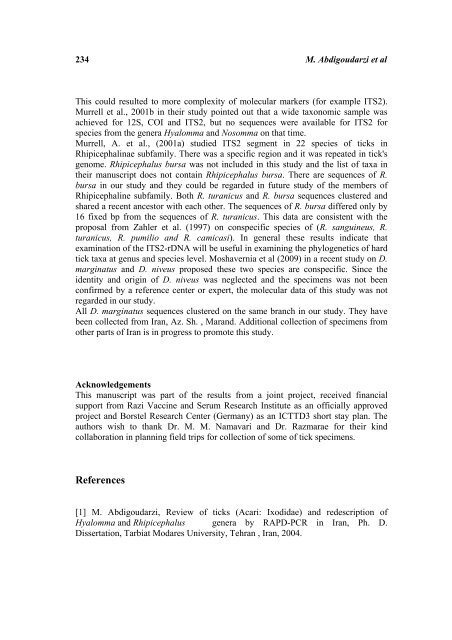rDNA-ITS2 Identification of Hyalomma, Rhipicephalus ... - HIKARI Ltd
rDNA-ITS2 Identification of Hyalomma, Rhipicephalus ... - HIKARI Ltd
rDNA-ITS2 Identification of Hyalomma, Rhipicephalus ... - HIKARI Ltd
You also want an ePaper? Increase the reach of your titles
YUMPU automatically turns print PDFs into web optimized ePapers that Google loves.
234 M. Abdigoudarzi et al<br />
This could resulted to more complexity <strong>of</strong> molecular markers (for example <strong>ITS2</strong>).<br />
Murrell et al., 2001b in their study pointed out that a wide taxonomic sample was<br />
achieved for 12S, COI and <strong>ITS2</strong>, but no sequences were available for <strong>ITS2</strong> for<br />
species from the genera <strong>Hyalomma</strong> and Nosomma on that time.<br />
Murrell, A. et al., (2001a) studied <strong>ITS2</strong> segment in 22 species <strong>of</strong> ticks in<br />
Rhipicephalinae subfamily. There was a specific region and it was repeated in tick's<br />
genome. <strong>Rhipicephalus</strong> bursa was not included in this study and the list <strong>of</strong> taxa in<br />
their manuscript does not contain <strong>Rhipicephalus</strong> bursa. There are sequences <strong>of</strong> R.<br />
bursa in our study and they could be regarded in future study <strong>of</strong> the members <strong>of</strong><br />
Rhipicephaline subfamily. Both R. turanicus and R. bursa sequences clustered and<br />
shared a recent ancestor with each other. The sequences <strong>of</strong> R. bursa differed only by<br />
16 fixed bp from the sequences <strong>of</strong> R. turanicus. This data are consistent with the<br />
proposal from Zahler et al. (1997) on conspecific species <strong>of</strong> (R. sanguineus, R.<br />
turanicus, R. pumilio and R. camicasi). In general these results indicate that<br />
examination <strong>of</strong> the <strong>ITS2</strong>-<strong>rDNA</strong> will be useful in examining the phylogenetics <strong>of</strong> hard<br />
tick taxa at genus and species level. Moshavernia et al (2009) in a recent study on D.<br />
marginatus and D. niveus proposed these two species are conspecific. Since the<br />
identity and origin <strong>of</strong> D. niveus was neglected and the specimens was not been<br />
confirmed by a reference center or expert, the molecular data <strong>of</strong> this study was not<br />
regarded in our study.<br />
All D. marginatus sequences clustered on the same branch in our study. They have<br />
been collected from Iran, Az. Sh. , Marand. Additional collection <strong>of</strong> specimens from<br />
other parts <strong>of</strong> Iran is in progress to promote this study.<br />
Acknowledgements<br />
This manuscript was part <strong>of</strong> the results from a joint project, received financial<br />
support from Razi Vaccine and Serum Research Institute as an <strong>of</strong>ficially approved<br />
project and Borstel Research Center (Germany) as an ICTTD3 short stay plan. The<br />
authors wish to thank Dr. M. M. Namavari and Dr. Razmarae for their kind<br />
collaboration in planning field trips for collection <strong>of</strong> some <strong>of</strong> tick specimens.<br />
References<br />
[1] M. Abdigoudarzi, Review <strong>of</strong> ticks (Acari: Ixodidae) and redescription <strong>of</strong><br />
<strong>Hyalomma</strong> and <strong>Rhipicephalus</strong> genera by RAPD-PCR in Iran, Ph. D.<br />
Dissertation, Tarbiat Modares University, Tehran , Iran, 2004.
















